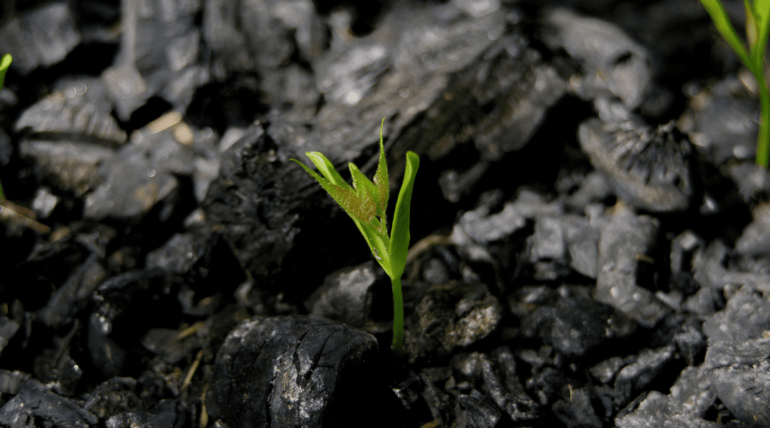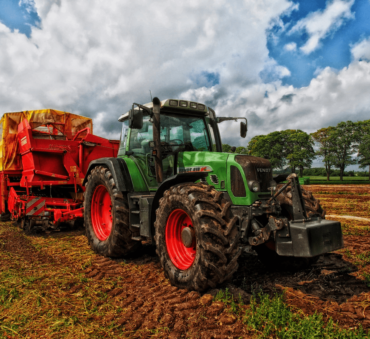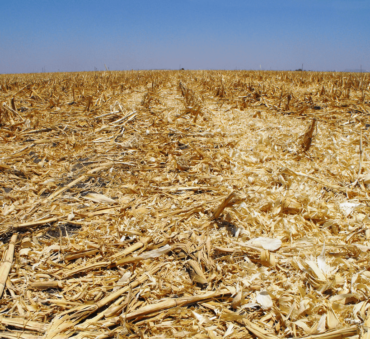In the crux of growing global needs, farming and agriculture face tremendous challenges. Waste management, maintaining productive yields, and minimizing environmental impacts – all within a backdrop of rising sustainability standards. Balancing productive output within these constraints is challenging. To navigate this delicate balance, innovative strategies are on the rise. Among these is biochar, a product of agricultural waste pyrolysis.
The promise of biochar as a tool for carbon sequestration and soil amendment has sparked curiosity among scientists, environmentalists, and agriculturalists, leading them to explore its potential benefits and drawbacks. This blog explores the fascinating world of the “black gold” revolutionizing soil and sustainability.
What is Biochar?
Biochar is a charcoal-like substance obtained by subjecting organic material, such as plant matter or agricultural waste, to a process known as pyrolysis. Pyrolysis involves heating this organic matter in the absence or near-absence of oxygen, preventing complete combustion and resulting in a carbon-rich residue.
While the term ‘biochar’ is of modern coinage, the concept is far from new. The roots of its usage can be traced back to ancient civilizations. For example, indigenous populations in the Amazon used charred organic matter to improve the fertility of their nutrient-poor soils, leading to the creation of extraordinarily fertile ‘Terra Preta’ (or ‘black earth’) soils. Today, its potential is being rediscovered, refined, and harnessed through modern scientific understanding and technology.
How to Make Biochar?
Biochar production follows a well-defined, intricate process:
- Feedstock Selection and Preparation: The initial stage involves choosing and preparing the organic material that will be transformed into biochar, known as the ‘feedstock’. This can be a variety of organic matter, but agricultural waste is commonly used due to its abundance and renewability. The feedstock is dried and sometimes shredded to optimize the pyrolysis process.
- Pyrolysis: The feedstock is then heated at temperatures typically ranging from 300 to 800°C in a low-oxygen environment. As we mentioned before, this controlled, oxygen-limited environment prevents the feedstock from simply burning away, causing it instead to decompose thermally. The organic material breaks down, releasing volatile components and leaving behind biochar.
- Cooling and Conditioning: The hot biochar is cooled down after pyrolysis. It might also undergo further processing, such as activation, to improve its properties based on its intended application.
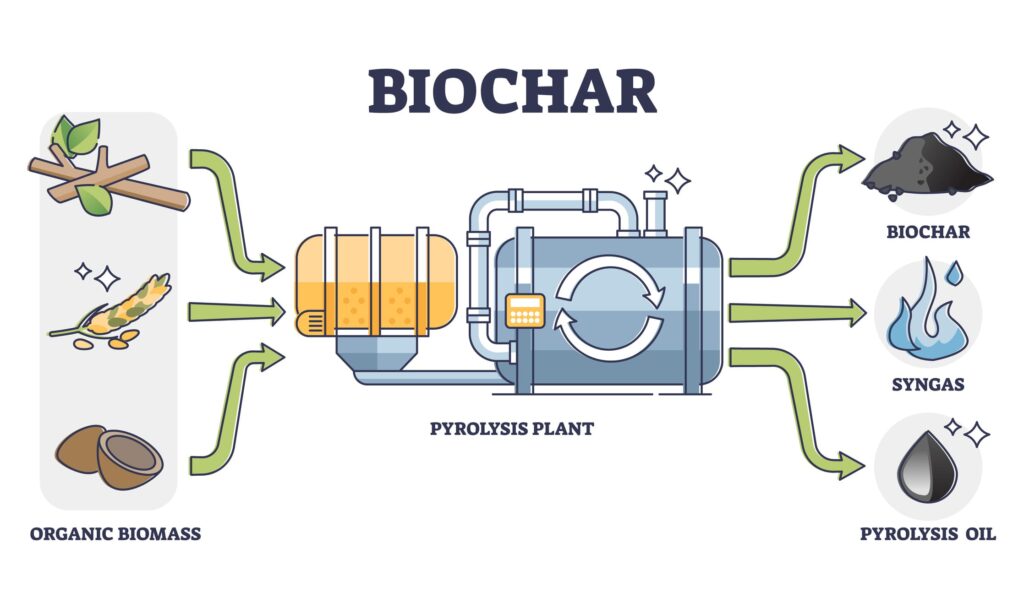
Biochar Uses and Applications
Its versatility has driven its increasing popularity. It’s found a particularly robust application in agriculture, contributing significantly to its efficiency and environmental friendliness.
Biochar Soil Amendment
With its porous nature and ability to retain water, biochar amends sandy soils that struggle with water retention and nutrient availability. Its negatively charged particles attract and hold onto positively charged, essential plant nutrients. So, the nutrients stay within the soil, reducing leaching and keeping them ready for plant uptake. Notably, it encourages the growth of beneficial soil microorganisms, which are crucial for nutrient cycling and overall soil health. All these contribute to healthier plants and higher crop yields.
Biochar Composting
In addition to being used directly as a soil amendment, it can be integrated into composting practices. When added to compost piles, it can improve the composting process by helping to retain moisture and nutrients and by providing a habitat for compost-friendly microbes. The resulting biochar-compost blend provides an excellent soil conditioner.
Biochar in Livestock Farming
Livestock farming can also benefit from biochar. Mixed with livestock feed, it can improve animal health, potentially enhancing disease resistance and feed efficiency. And it doesn’t stop there; when used as a bedding material in barns, it can absorb odors and reduce harmful methane emissions. The used bedding, rich in nutrients, can later be used as a soil amendment, creating a full circle of sustainability.
Biochar Benefits
Biochar indeed comes with a slew of benefits, both for the environment and for the agricultural economy.
Environmental Benefits
Mitigating Climate Change
The link between biochar and climate change mitigation is well established, thanks to its dual role in reducing greenhouse gas emissions. Biochar production presents a clean decomposition alternative, emitting fewer greenhouse gases compared to other processes such as composting.
Additionally, when incorporated into the soil, it can limit nitrous oxide emissions. This greenhouse gas is almost 300 times more effective at trapping heat in the atmosphere than carbon dioxide, and agricultural soils are a significant contributor. By limiting nitrous oxide emissions, it directly participates in combating climate change.
Biochar as a Carbon Sink
One of the most unique and beneficial features is its ability to sequester carbon. The process of creating biochar effectively locks carbon into a stable form that can be stored in the soil for hundreds or even thousands of years. This “carbon locking” property enables it to act as a carbon sink, capturing and holding carbon that would otherwise be released into the atmosphere as carbon dioxide.
Economic Benefits
Sustainability in Agriculture
Embracing biochar in agricultural practices can lead to significant economic benefits. It starts with its innate capacity to enhance soil fertility. With the soil’s health amplified, the need for synthetic fertilizers is reduced. This not only leads to cost savings but also promotes sustainable agriculture as the reliance on chemicals decreases.
This improved soil fertility also paves the way for better crop yields, which in turn can mean higher income from sales.
Waste Management and Cost Efficiency
Instead of bearing the costs of agricultural waste disposal, biochar is a great alternative because it’s not just eco-friendly but also cost-efficient, as it provides an effective way to manage waste without incurring disposal fees.
Additionally, the process also produces syngas and bio-oil, which can be used as renewable energy sources. This can lead to reduced energy costs, contributing to overall operational savings.
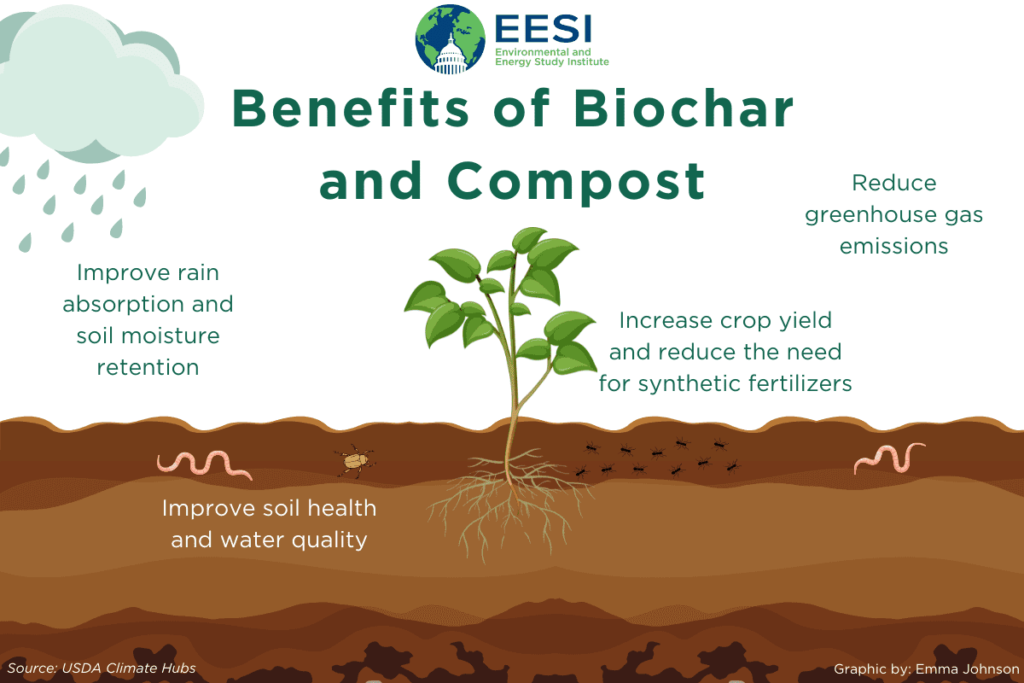
Disadvantages of Biochar
While the advantages have made it an attractive choice for sustainable agriculture, it is essential to acknowledge that, like any other practice, it also comes with potential downsides:
Changes in Soil Properties
One of the unfortunate issues associated with biochar use lies in its potential to alter soil properties. Being highly porous and rich in carbon, it can indeed change the physical and chemical characteristics of the soil. While this can improve soil fertility, water retention, and nutrient availability, it can also inadvertently lead to over-saturation of certain nutrients, potentially inducing imbalances in soil nutrient dynamics.
Potential Reduction in Pesticide Efficiency
Another potential downside lies in its capacity to decrease the efficiency of some pesticides. Given its high absorption potential, it could absorb and retain pesticides applied to the soil, reducing their availability to target pest organisms. This might require higher application rates of pesticides to achieve desired pest control levels, which could increase farming costs and potentially heighten the risk of environmental pollution.
Risk of Pollution
If not managed appropriately, biochar production can lead to environmental pollution. The pyrolysis process can release pollutants, including particulate matter, volatile organic compounds, and polycyclic aromatic hydrocarbons. Some of these compounds are toxic, carcinogenic, or can contribute to climate change. Therefore, strict controls and management strategies are needed during production to minimize pollutant emissions.
Health Implications
Direct contact with or inhalation of biochar dust could potentially pose health risks. This could range from minor irritations to more serious respiratory issues, especially if it contains harmful substances. As such, safe handling and application procedures should be in place to minimize any health risks associated with its use.
Despite these challenges, it’s essential to remember that many of these risks can be managed or mitigated with careful and informed use. Additionally, continued research and development in the field will help us understand these drawbacks better and find ways to minimize them. This reinforces the importance of working with expert organizations like Shapiro, who are well-versed in all major organic waste management techniques.
How to use biochar the right way?
When produced and used responsibly, it can serve as a powerful tool for sustainable agriculture. However, improper waste management or inadequate production practices can lead to adverse impacts. This underscores the value of expert organizations like Shapiro. With a commitment to responsible waste management, international reach, and adherence to strict standards, Shapiro collaborates with the best in the field to employ advanced waste management techniques.
In summary, biochar holds the potential to revolutionize farming. Its ability to turn waste into a valuable product, boost soil health, and sequester carbon makes it an innovation worthy of recognition. Yet, we can only harness the full potential of it through responsible management, ensuring it emerges as a beacon of sustainability in agriculture.
Looking for a comprehensive agricultural waste management and recycling service With Shapiro at your side, you’re choosing a path of efficiency, productivity, and eco-friendliness. Unlock the full potential of your agricultural practices with our biochar solutions. Experience a new level of soil health and waste reduction. Reach out now to explore how we can turn your agricultural residues into valuable assets for a sustainable tomorrow.
Contact us today and let’s set the wheels in motion for a greener, healthier, and more prosperous future.
Frequently Asked Questions
The best source of biochar typically comes from plant waste materials. This can include corn stalks or husks, wood chips, or manure. These materials are readily available and often considered waste, making them a sustainable and cost-effective source for biochar production.
Wood and agricultural waste are often regarded as the best biomass for biochar due to their high carbon content and low environmental impact. These materials are rich in organic matter, and their pyrolysis yields higher quality. Moreover, using these types of waste materials helps in waste management and promotes sustainability.
The chemical composition of biochar varies depending on the type of biomass used and the conditions during pyrolysis. Generally, it is predominantly composed of carbon, along with varying amounts of hydrogen, oxygen, nitrogen, and smaller amounts of other elements. it also contains inorganic minerals from the original biomass, such as calcium, potassium, and phosphorus.
While both biochar and charcoal are produced through the process of pyrolysis, they are not the same. Charcoal is primarily used as a fuel source for heating and cooking, while biochar is designed for soil amendment, aiming to improve soil fertility and sequester carbon. Moreover, the production of biochar is often carried out under more controlled conditions to maximize its beneficial properties for soil use.
Some objections to biochar stem from concerns about potential environmental impacts, such as changes in soil pH, nutrient imbalance, or potential release of toxins during the pyrolysis process. There are also worries about the sustainability of feedstock sourcing for biochar production. Proper regulation, responsible production, and application practices are essential to address these concerns and ensure its benefits are fully realized.
